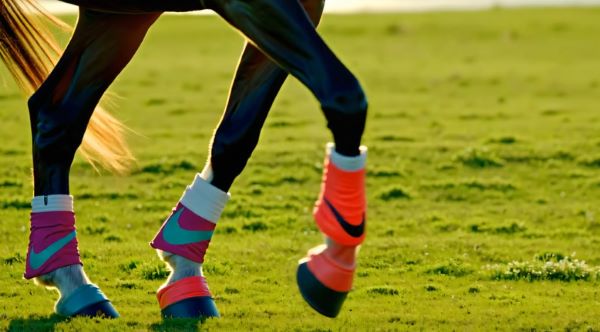Was your horse born with shoes on?
Horses might think it strange, watching humans try and improve 60 million years of evolution.
Shoes are a curious concept when you consider shoeing prevents the hoof from working as a flexible system, the way nature intended. The hoof expands and contracts as a suspension would.
Why bolt this ingenious structure to rigid steel, canceling out 75% of the horse’s ability to absorb shock? Its ligaments and joints must cope with trauma they’re not designed to take.
The flex of the hoof pumps blood to the feet, delivering nutrients to the hoof’s White Line. The White Line holds the hoof wall to the coffin bone – and it needs a lot of blood. It’s estimated that a medium sized, barefoot horse, pumps a gallon of blood to its feet in just 20 strides. No wonder shod horses quickly develop a weak, stretchy White Line.
Marjorie Smith has barefoot trimmed her horses since 1998. As she says, “I don’t think I’ve ever seen a horse that was shod for more than a year that didn’t have White Line damage.”
And it’s not just a case of the horse being able to feel the ground which it would naturally prefer.
So why do we put such untold strain on our horses’ feet?
Some would say it’s just tradition. We believe shoeing horses is right because previous generations have all done the same.
Horseshoes go right back to the days of knights, castles, kings and queens. Shoeing made sense. It prevented the hoof from falling apart on damp castle floors. It also enabled the horse to sustain prolonged periods of battle, carrying the knight – and all that heavy armour.
But in the 21st Century, we’re just creating diseased, malfunctioning hooves. So says Veterinarian Tom Tesky, “In my practice, the incidence of limb disease and injury is 70% higher amongst shod horses”.
Is it time for you and your horse to embrace natural horse care?
Get started by reading my page on barefoot transitioning
Here’s something really useful
And now onto Mac.

Born with Shoes On? Let’s Clear It Up!
“Ever heard someone say, “That horse looks like it was born with shoes on!”? It’s a fun expression, but what does it really mean? Horses definitely aren’t born with shoes on—thank goodness, because can you imagine a foal clunking around in horseshoes? But the phrase usually describes a horse that’s well-trained, surefooted, or just naturally good at what they do, almost like they’ve been prepared for the job from birth.”
“Of course, no horse is actually born with shoes on. Foals come into the world with soft, rubbery hooves designed to protect their moms during pregnancy and allow for smooth movement right after birth. It’s nature’s way of keeping things gentle until their hooves harden up over the next few days.”
“When people say a horse was born with shoes on, it’s often a compliment. It might mean the horse seems effortless under saddle, has great conformation, or is just an all-around natural talent. But behind every “born with shoes on” horse is a lot of training, care, and good management. Even the most naturally gifted horses need guidance to truly shine.”
“If your horse wasn’t “born with shoes on,” don’t worry—most aren’t! With consistent training, proper hoof care, and a little patience, any horse can develop into a confident partner. Whether they’re pulling off dressage moves, clearing jumps, or just being the best trail buddy ever, it’s the effort you put in together that really counts.”
“So, while no horse is literally born with shoes on, some do make it look like they were. And with the right care and attention, your horse can feel just as extraordinary! Mac”
Next up
Many horses are unable to be ridden barefoot and some methods of transitioning are down right cruel. Perhaps line breeding and interfering with genetics and trying to breed for speed has played a bigger role here, since the evolution of equus. Nothing wrong with shoes as long as they are removed for a few months of the year when the horse is resting.